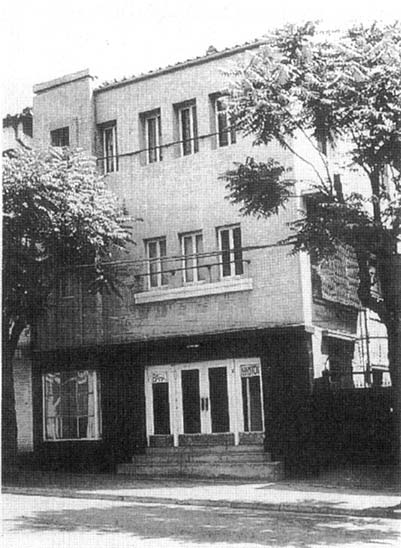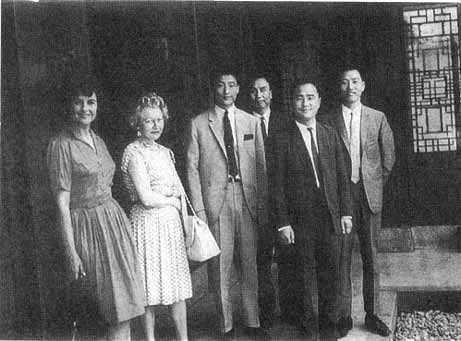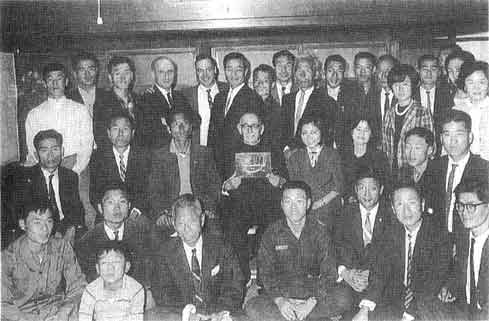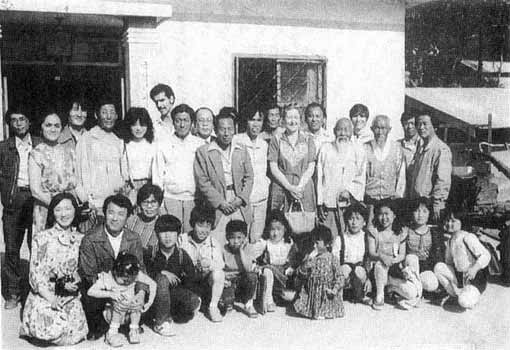
|
Raising the Banner in Korea:
An Early Bahá'í History
by Barbara R. Sims
 |
chapter 11 | start page | single page |
Chapter 12
12. Later Years
In 1965 the printing of Bahá'u'lláh and the New Era was accomplished. It was translated from the Japanese and Esperanto editions by Mr. Kim Chang-zin. He had started working on the translation in 1957 but as he could not work on it steadily it took him eight years.Also in 1965 a Certificate of Incorporation was issued by the government. The same year the National Spiritual Assembly acquired a National Hazíratu'l-Quds in Seoul, assisted by contributions from the National Spiritual Assemblies of Iran and North East Asia and donations from individual Bahá'ís.

The National Hazíratu'l-Quds in Seoul in a photo taken soon after its acquisition in 1965. The acquisition was a goal of the Nine Year Plan (1964-1973).
In 1966 Hand of the Cause Mr. Tarazullah Samandari visited Korea for nine days, accompanied by Mr. Ruhollah Mumtazi, a pioneer to Japan. Mr. Samandari met with the National Spiritual Assembly and gave "many useful ideas of teaching" according to a report. A report by Auxiliary Board Member Mr. Yang stated that Mr. Samandari visited seven localities, including Wolsong county, the mass-conversion area, and met 233 Bahá'ís and had publicity in three newspapers.
Publications that year were two pamphlets, "Life After Death" and "Bahá'í Teachings of a World Faith."
Mr. Kang Hyon-oh, chairman of the Masan Local Spiritual Assembly, passed away on October 12, 1966. He had opened the Bahá'í community of Masan which was able to elect an assembly in 1966. Auxiliary Board Member Yang called Mr. Kang "the most active teacher."
Also in 1966 the first Korean Bahá'í Youth Conference was held in October at the Seoul Hazíratu'l-Quds, which had been purchased the year before. About 45 youth attended. According to a report, this conference was the beginning of youth activities throughout Korea.

Hand of the Cause Mr. A.Q. Faizi is giving a speech during his visit to Korea in 1967. Mr. Cho Jin-yong is translating.
Other Hands of the Cause to visit Korea were Mr. John Robarts in 1968, Mr. Ali Akbar Furutan in 1969 and Mr. Collis Featherstone in 1971, 1973 and at least one other time with his wife, Madge. In 1974 Hand of the Cause William Sears visited Korea with his wife, Marguerite. Hand of the Cause Amatul-Baha Ruhiyyih Khanum honored Korea with a visit in 1984.

click for larger image
The author, Mrs. Sims, far left, is shown during a visit to Korea in 1967. Next to her is Mrs. Elizabeth McHenry, (mother of Auxiliary Board Member John McHenry III), and other members of the National Spiritual Assembly.
In 1970 a direct proclamation was presented to President Park Chung Hee. He wrote the Bahá'ís a cordial letter of acknowledgement.
The government recognized the Bahá'í marriage and Holy Days in 1971.
In 1971 the largest teaching conference to date was held in Seoul, with over 400 Bahá'ís attending. Almost half of the participants were from other countries and had just come from the North Pacific Oceanic Conference in Sapporo, Japan.
The end of the Nine Year Plan given by the Universal House of Justice was 1973. According to a report in The Bahá'í World Vol. XV, all of the goals of the Plan related to expanding the Faith to three hundred localities and establishing one hundred Local Spiritual Assemblies were accomplished. Actually by Ridván 1973 the number of localities where Bahá'ís resided was 557, more than five times the number at the beginning of the Plan, and more than twice the number at Ridván 1968.
A major accomplishment in 1976 was the establishment of the Bahá'í Publishing Trust of Korea.
ln 1988 Dr. Kim Myung Jung was appointed Counsellor in Korea by the Universal House of Justice, the first Korean Bahá'í to be so honored.

click for larger image
Hand of the Cause Mr. Tarazu'llah Samandari visited Bahá'ís in seven locations and had publicity in three newspapers during his trip to Korea in 1966. Accompanying him was Mr. Ruhollah Mumtazi from Japan, standing fourth from the left. Standing next to Mr. Mumtazi is Mr. Eugene Schreiber who, with his Japanese wife Akiko, standing at the far right, was pioneering in Korea. This photo was taken in Seoul.

click for larger image
Hand of the Cause Ali Akbar Furutan visited Korea in 1969. Shown here are Mr. Furutan, Counsellor Mr. Vic Samaniego from the Philippines, Auxiliary Board Member Mr. Yang Jae-ho, Mrs. Ridvaniyyih Suleimani, an Auxiliary Board Member in Taiwan and Mrs. Ok-sun McHenry at the Kyongju Bahá'í Center.

Hand of the Cause Mr. Samandari with a gentleman from Kyongju, who, unfortunately, was not identified.

click for larger image
56

click for larger image
A Certificate of Incorporation of the National Spiritual Assembly of the Bahá'ís of Korea dated March 19, 1965, issued by the government. The incorporation of the National Spiritual Assembly was a goal of the Nine Year Plan (1964-1973).

Hand of the Cause Collis Featherstone being interviewed on MBC Television in Taejun 1973.

click for larger image
In 1984 the Bahá'ís in Korea were honored by a visit from Hand of the Cause Amatul-Baha Ruhiyyih Khanum. She is shown here with Bahá'í friends on the island of Anja. Her travel companion Mrs. Violette Nakhjavani is standing on the left side.
This was the largest conference in Korea up to that time. It was a post-conference held after the North Pacific Oceanic Conference in Sapporo, Japan, 1971. According to statistics, the Korean conference was attended by 302 Korean Bahá'ís and 163 Bahá'ís from foreign countries who included this conference on their way home from Japan. It was attended by Hand of the Cause Mr. Collis Featherstone.

click for larger image
Certificate of Registration of the Bahá'í Publishing Trust of Korea, with the translation into English; February 16, 1976.
Afterword
With a few exceptions the scope of this book is limited to the 1950s and early 1960s, as after that the National Spiritual Assembly of Korea was keeping its own records and news from various national communities was more readily available to researchers through The Bahá'í World volumes, Bahá'í International News Service editions, regular reports to the World Center in Haifa, etc.
However, records of the very early days are not so readily available. There are a few accounts in the U.S. Bahá'í News editions but much of the contents herein come from reports sent by pioneers in Korea to Hand of the Cause Miss Alexander and to the National Spiritual Assembly of North East Asia and the Asia Teaching Committee of the National Spiritual Assembly of the United States. The compiler is indebted to Dr. William Maxwell, Mr. John McHenry III, Miss Lecile Webster, Mr. William Smits and Mrs. Lee Gap Sun for helping to identify people and answer questions. She wishes to thank members of the National Spiritual Assembly of the Bahá'ís of Korea and the National Office staff for invaluable assistance checking research points in the final stages of this project.
Mrs. Margaret Ruhe supplied the information that her father and mother, Professor and Mrs. Kuntz, made their pilgrimage March/April 1921 thereby confirming the year that Mr. Roe (Roh Chung-il, who had met Professor and Mrs. Kuntz on board their ship) gained the presence of 'Abdu'l-Bahá.
When the author was compiling histories for Korea and other countries in Asia, she was often struck by the changing of people's attitudes through their years. For example, Mr. Kim Chang-zin, the first Korean to believe in Bahá'u'lláh, remained faithful through the years, unchanging to the end of his long life. Whereas, in contrast, some of the other very eager and firm Bahá'ís, having had an important part in the development of the Faith in their land, sometimes for years, would, after a certain length of time, go inactive, often for no apparent reason. Their service, although short, was vital at a time when every single soul who believed in Bahá'u'lláh had such
The author was also struck by the pure hearts of the early pioneers. It is impossible to convey how incredibly difficult areas such as Korea were to live and teach in, in the early days, and how steadfastly the pioneers clung to their posts, relying only on Bahá'u'lláh to assist them. In those early days there were no jet aircraft, no efficient heaters or air conditioning, no comfortable hotels, and few or no livable apartments, often no adequate food or even suitable clothing, and few conveniences or amenities of any kind and usually no friends within reach, and little money to improve their circumstances. Of the letters written by the friends in Korea to the National Spiritual Assembly of North East Asia, many concerned finances. There was often barely enough money to do even necessary things like ordering pamphlets and books, printing in the native language, renting "centers," which really meant renting rooms, often very small, in which to have meetings, and paying transportation to new areas for people to go for the purpose of teaching the Faith. A phrase in a letter written on behalf of the Guardian, Shoghi Effendi, comes to mind, which said that isolated pioneers are like a light-house of Bahá'u'lláh shining at a strategic point and casting its beam out into the darkness.
If the American presence seems large in the early days of the Faith in Korea, it is because it was so. In addition to those Bahá'ís mentioned in the text the following names should be recorded: Jimmy Bates, Frederick Fultz, Donald Oja, Ernest Jones and Walter Owens -- all servicemen with the U.S. Armed Forces in Korea in the 1950s and 1960s; also Mr. Charles Duncan, who resided in Korea 1967-1971.
Of the countries about which I have collected information to write of the early days, Korea seems to have been the most deprived, yet the Korean people have shown a resiliency, a determination, a dynamic quality second to none in the Asian countries as demonstrated by the growth of the Faith there and, indeed, by the growth of Korea into a modern, industrial nation.
Sources
-
Letters, documents, reports, photographs from the Agnes Alexander collection
as well as the files of the National Spiritual Assembly of the
Bahá'ís of North East Asia and the National Spiritual Assembly of
the Bahá'ís of Japan, all of which are held at the Archives in
the National Bahá'í Center, Tokyo, Japan
The National Bahá'í Archives of the United States
The National Spiritual Assembly of the Bahá'ís of Korea
The National Bahá'í Archives of Korea
U.S. Bahá'í News, various issues
The Bahá'í World, Vols. II, XV
 |
chapter 11 | start page | single page |
|
|
